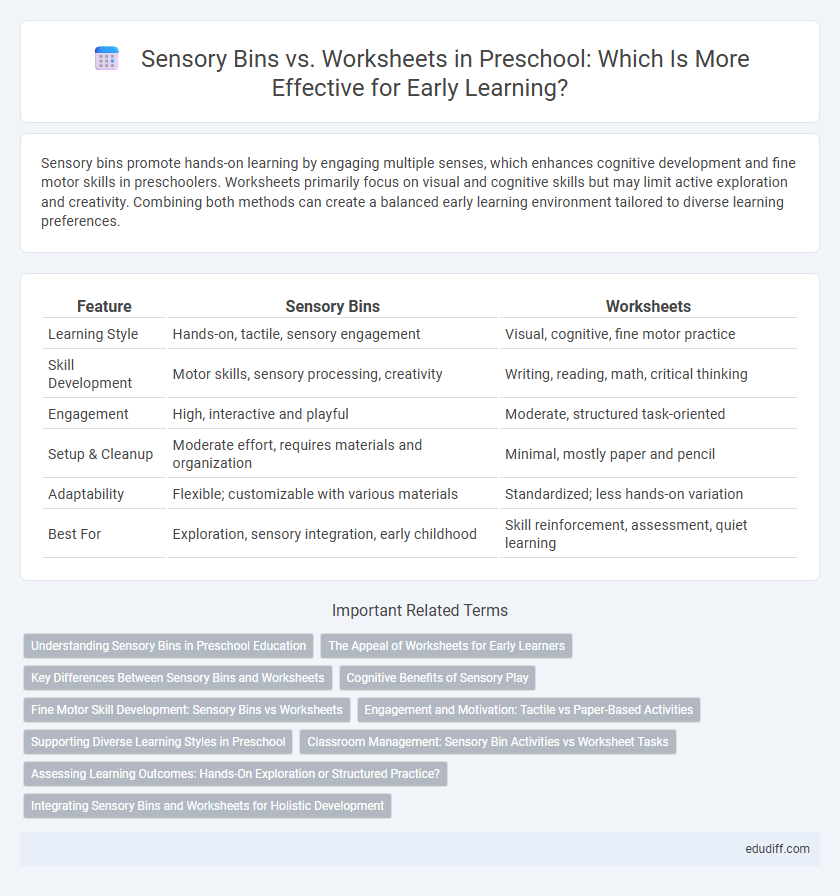Sensory bins promote hands-on learning by engaging multiple senses, which enhances cognitive development and fine motor skills in preschoolers. Worksheets primarily focus on visual and cognitive skills but may limit active exploration and creativity. Combining both methods can create a balanced early learning environment tailored to diverse learning preferences.
Table of Comparison
| Feature | Sensory Bins | Worksheets |
|---|---|---|
| Learning Style | Hands-on, tactile, sensory engagement | Visual, cognitive, fine motor practice |
| Skill Development | Motor skills, sensory processing, creativity | Writing, reading, math, critical thinking |
| Engagement | High, interactive and playful | Moderate, structured task-oriented |
| Setup & Cleanup | Moderate effort, requires materials and organization | Minimal, mostly paper and pencil |
| Adaptability | Flexible; customizable with various materials | Standardized; less hands-on variation |
| Best For | Exploration, sensory integration, early childhood | Skill reinforcement, assessment, quiet learning |
Understanding Sensory Bins in Preschool Education
Sensory bins in preschool education provide hands-on, multi-sensory experiences that enhance fine motor skills, cognitive development, and language acquisition by allowing children to explore textures, shapes, and materials in an interactive way. Unlike static worksheets, sensory bins promote active learning through tactile engagement, supporting brain development and sensory integration critical for early childhood. Educators often use sensory bins to foster creativity, problem-solving, and social interaction among preschoolers, making them a dynamic tool for experiential learning.
The Appeal of Worksheets for Early Learners
Worksheets offer structured activities that help preschoolers develop fine motor skills and early literacy through tracing, coloring, and matching exercises. They provide clear, repetitive tasks that support cognitive development, following educational standards and measurable learning objectives. The appeal lies in their ease of use for parents and educators, enabling consistent practice and assessment in foundational concepts like letters, numbers, and shapes.
Key Differences Between Sensory Bins and Worksheets
Sensory bins engage preschoolers through tactile exploration, promoting fine motor skills and sensory development, while worksheets primarily focus on cognitive skills like counting, letter recognition, and pattern identification. Sensory bins encourage hands-on learning and creativity, fostering social interaction and problem-solving, whereas worksheets offer structured practice and measurable progress in specific academic areas. The key difference lies in sensory bins being play-based and experiential, contrasting with the more formal, task-oriented nature of worksheets.
Cognitive Benefits of Sensory Play
Sensory bins promote cognitive development in preschoolers by enhancing fine motor skills, problem-solving abilities, and neural connections through hands-on exploration. Unlike worksheets, sensory play engages multiple senses simultaneously, fostering creativity and improving memory retention. Research shows children involved in sensory-rich activities demonstrate greater attention span and critical thinking skills necessary for early learning success.
Fine Motor Skill Development: Sensory Bins vs Worksheets
Sensory bins provide hands-on tactile experiences that enhance fine motor skills through activities like scooping, pouring, and manipulating small objects, which engage multiple senses simultaneously. Worksheets primarily develop fine motor control by encouraging precise pencil grip and controlled hand movements during tasks such as coloring, tracing, and cutting. Integrating sensory bins with worksheet activities offers a balanced approach to strengthening young children's fine motor development effectively.
Engagement and Motivation: Tactile vs Paper-Based Activities
Sensory bins provide hands-on, tactile experiences that significantly boost preschoolers' engagement and motivation by allowing exploration through touch, texture, and movement. In contrast, paper-based worksheets offer structured learning but often lack the dynamic interaction that sustains young children's interest. Incorporating sensory bins in early childhood education promotes active participation and enhances cognitive development more effectively than traditional worksheet methods.
Supporting Diverse Learning Styles in Preschool
Sensory bins engage tactile, auditory, and visual senses, promoting hands-on exploration that supports kinesthetic and sensory learners in preschool. Worksheets provide structured practice ideal for visual and logical learners who benefit from patterns and repetition in early literacy and numeracy skills. Combining sensory bins with worksheets creates a balanced approach that addresses diverse learning styles, enhancing cognitive development and fine motor skills in young children.
Classroom Management: Sensory Bin Activities vs Worksheet Tasks
Sensory bins promote active engagement and hands-on learning, making classroom management smoother by keeping preschoolers focused and minimizing disruptive behavior. Worksheets, while structured and easy to distribute, often result in passive participation, leading to restlessness and increased need for redirection. Incorporating sensory bin activities can enhance attention span and foster collaborative interaction, reducing the teacher's effort to maintain order.
Assessing Learning Outcomes: Hands-On Exploration or Structured Practice?
Sensory bins enhance cognitive development by promoting hands-on exploration, sensory integration, and fine motor skills, making them effective for assessing experiential learning outcomes in preschool. Worksheets provide structured practice that supports foundational literacy and numeracy skills, offering measurable data for evaluating knowledge retention and task completion. Combining sensory bins with worksheets creates a balanced approach, catering to diverse learning styles and yielding comprehensive insights into preschoolers' development.
Integrating Sensory Bins and Worksheets for Holistic Development
Integrating sensory bins and worksheets in preschool education enhances holistic development by combining tactile exploration with structured learning, promoting both fine motor skills and cognitive understanding. Sensory bins stimulate sensory processing and creativity, while worksheets reinforce concepts like letters, numbers, and shapes through repetition and focus. Utilizing both tools together supports diverse learning styles and fosters comprehensive growth in early childhood development.
Sensory bins vs Worksheets Infographic

 edudiff.com
edudiff.com